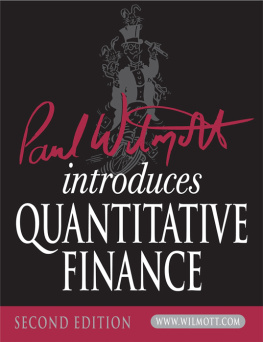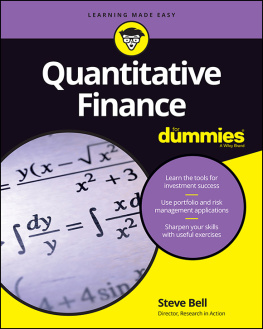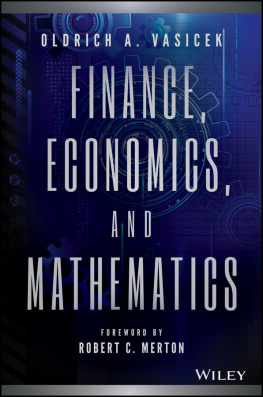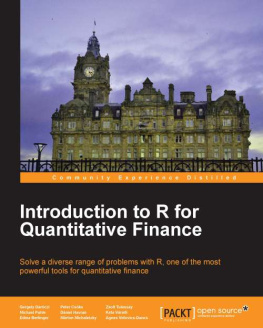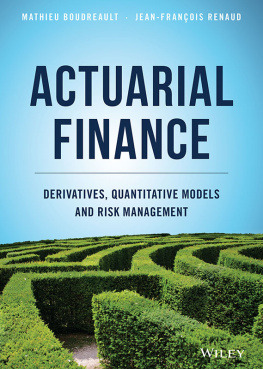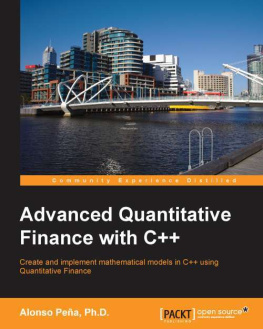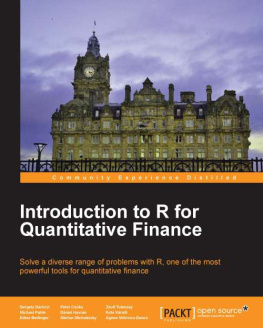Paul Wilmott
Introduces
Quantitative Finance
Second Edition
2007 Paul Wilmott
Published by John Wiley & Sons, Ltd
Registered office
John Wiley & Sons Ltd, The Atrium, Southern Gate, Chichester, West Sussex, PO19 8SQ, United Kingdom
For details of our global editorial offices, for customer services and for information about how to apply for permission to reuse the copyright material in this book please see our website at www.wiley.com .
All rights reserved. No part of this publication may be reproduced, stored in a retrieval system, or transmitted, in any form or by any means, electronic, mechanical, photocopying, recording or otherwise, except as permitted by the UK Copyright, Designs and Patents Act 1988, without the prior permission of the publisher.
Wiley publishes in a variety of print and electronic formats and by print-on-demand. Some material included with standard print versions of this book may not be included in e-books or in print-on-demand. If this book refers to media such as a CD or DVD that is not included in the version you purchased, you may download this material at http://booksupport.wiley.com . For more information about Wiley products, visit www.wiley.com .
Designations used by companies to distinguish their products are often claimed as trademarks. All brand names and product names used in this book are trade names, service marks, trademarks or registered trademarks of their respective owners. The publisher is not associated with any product or vendor mentioned in this book.
Limit of Liability/Disclaimer of Warranty: While the publisher and author have used their best efforts in preparing this book, they make no representations or warranties with the respect to the accuracy or completeness of the contents of this book and specifically disclaim any implied warranties of merchantability or fitness for a particular purpose. It is sold on the understanding that the publisher is not engaged in rendering professional services and neither the publisher nor the author shall be liable for damages arising herefrom. If professional advice or other expert assistance is required, the services of a competent professional should be sought.
Anniversary Logo Design: Richard J. Pacifico.
Library of Congress Cataloging-in-Publication Data
Wilmott, Paul.
Paul Wilmott introduces quantitative finance.2nd ed.
p. cm.
ISBN 978-0-470-31958-1
1. FinanceMathematical models. 2. Options (Finance)Mathematical models. 3. Options (Finance)Prices
Mathematical models. I. Title. II Title: Quantitative finance.
HG173.W493 2007
332dc22
2007015893
A catalogue record for this book is available from the British Library.
ISBN 978-0-470-31958-1 (PB)
To a rising Star
Preface
In this book I present classical quantitative finance. The book is suitable for students on advanced undergraduate finance and derivatives courses, MBA courses, and graduate courses that are mainly taught, as opposed to ones that are based on research. The text is quite self-contained, with, I hope, helpful sidebars (Time Out) covering the more mathematical aspects of the subject for those who feel a little bit uncomfortable. Little prior knowledge is assumed, other than basic calculus, even stochastic calculus is explained here in a simple, accessible way.
By the end of the book you should know enough quantitative finance to understand most derivative contracts, to converse knowledgeably about the subject at dinner parties, to land a job on Wall Street, and to pass your exams.
The structure of the book is quite logical. Markets are introduced, followed by the necessary math and then the two are melded together. The technical complexity is never that great, nor need it be. The last three chapters are on the numerical methods you will need for pricing. In the more advanced subjects, such as credit risk, the mathematics is kept to a minimum. Also, plenty of the chapters can be read without reference to the mathematics at all. The structure, mathematical content, intuition, etc., are based on many years teaching at universities and on the Certificate in Quantitative Finance, and training bank personnel at all levels.
The accompanying CD contains spreadsheets and Visual Basic programs implementing many of the techniques described in the text. The CD icon will be seen throughout the book, indicating material to be found on the CD, naturally. There is also a full list of its contents at the end of the book.
You can also find an Instructors Manual at www.wiley.com/go/pwiqf2 containing answers to the end-of-chapter questions in this book. The questions are, in general, of a mathematical nature but suited to a wide range of financial courses.
This book is a shortened version of Paul Wilmott on Quantitative Finance, second edition. Its also more affordable than the full version. However, I hope that youll eventually upgrade, perhaps when you go on to more advanced, research-based studies, or take that job on The Street.
PWOQF is, I am told, a standard text within the banking industry, but in Paul Wilmott Introduces Quantitative Finance I have specifically the university student in mind.
The differences between the university and the full versions are outlined at the end of the book. And to help you make the leap, weve included a form for you to upgrade, giving you a nice discount. Roughly speaking, the full version includes a great deal of non-classical, more modern approaches to quantitative finance, including several non-probabilistic models. There are more mathematical techniques for valuing exotic options and more markets are covered. The numerical methods are described in more detail.
If you have any problems understanding anything in the book, find errors, or just want a chat, email me at to discuss quantitative finance, and other subjects, with other people in this business.
I would like to thank the following people. My partners in various projects: Paul and Jonathan Shaw and Gil Christie at 7city, unequaled in their dedication to training and their imagination for new ideas. Also Riaz Ahmad, Seb Lleo and Siyi Zhou who have helped make the Certificate in Quantitative Finance so successful, and for taking some of the pressure off me. Everyone involved in the magazine, especially Aaron Brown, Alan Lewis, Bill Ziemba, Caitlin Cornish, Dan Tudball, Ed Lound, Ed Thorp, Elie Ayache, Espen Gaarder Haug, Graham Russel, Henriette Prst, Jenny McCall, Kent Osband, Liam Larkin, Mike Staunton, Paula Soutinho and Rudi Bogni. I am particularly fortunate and grateful that John Wiley & Sons have been so supportive in what must sometimes seem to them rather wacky schemes. I am grateful to James Fahy for his work on my websites, and apologies for always failing to provide a coherent brief. Thanks also to David Epstein for help with the exercises, again; to Ron Henley, the best hedge fund partner a quant could wish for: Its just a jump to the left. And then a step to the right; to John Morris of Fulcrum, interesting times; to all my lawyers for keeping the bad people away, Jared Stamell, Richard Schager, John Crow, Harry Issler, David Price and Kathryn van Gelder; and, of course, to Nassim Nicholas Taleb for entertaining chats.
Thanks to John, Grace, Sel and Stephen, for instilling in me their values. Values which have invariably served me well. And to Oscar and Zachary who kept me sane throughout many a series of unfortunate events!

